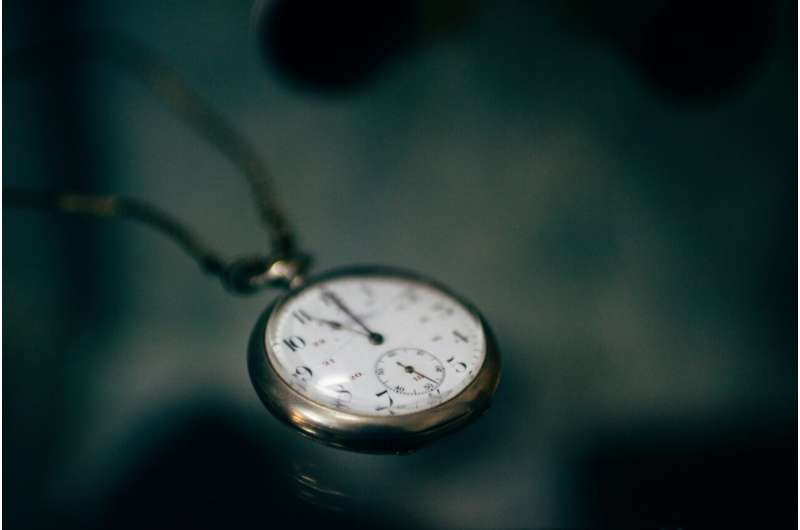This article has been reviewed according to Science X's editorial process and policies. Editors have highlighted the following attributes while ensuring the content's credibility:
fact-checked
peer-reviewed publication
trusted source
proofread
Synchronization between central and circadian clocks of tissues found to preserve their functioning, prevent aging

Two complementary research articles, published simultaneously in the journals Science and Cell Stem Cell by a team of scientists from the UPF and IRB Barcelona, reveal that central and peripheral circadian clocks coordinate to regulate the daily activity of skin and muscles.
The coordination between the two clocks (central and peripheral) guarantees 50% of the circadian functions of tissues, including vital processes such as the cell cycle, DNA repair, mitochondrial activity, and metabolism. Synchronization between the central brain clock and peripheral ones prevents premature muscle aging and improves muscle function, suggesting new strategies to tackle age-related decline through circadian rhythm modulation.
Discovered in the 1970s, circadian clocks are essential for the regulation of biological time in most cells in the human body. These internal mechanisms adjust biological processes to a 24-hour cycle, allowing the synchronization of cellular functions with daily variations in the environment.
Circadian rhythms, which are coordinated by a central clock in the brain that communicates with clocks in different peripheral tissues, influence many functions, from our sleep patterns to our ability to metabolize food.
A team led by Dr. Salvador Aznar Benitah, an ICREA researcher at IRB Barcelona, and Dr. Pura Muñoz-Cánoves, an ICREA researcher in the Department of Medicine and Life Sciences at the Pompeu Fabra University (UPF), has described how the synchronization between the central clock and peripheral clocks in muscle and skin plays a key role in ensuring the correct function of these tissues, as well as preventing degenerative processes associated with aging.
The research on the synchronization between the central and peripheral clocks appears in Science, while the work on the coordination between the central clock and skin peripheral clock has been released in Cell Stem Cell. Both studies reveal the common mechanisms that underscore the importance of this coordination to uphold the optimal functionality of muscle and skin.
The work also describes the remarkable degree of autonomy of the peripheral clocks, which can maintain 24-h cycles and manage approximately 15% of circadian functions in the absence of the central clock.
"It is fascinating to see how synchronization between the brain and peripheral circadian clocks plays a critical role in skin and muscle health, while peripheral clocks alone are autonomous in carrying out the most basic tissue functions," says Dr. Aznar Benitah, head of the Stem Cell and Cancer laboratory at IRB Barcelona.
"Our study reveals that minimal interaction between only two tissue clocks (one central and the other peripheral) is needed to maintain optimal functioning of tissues like muscles and skin and to avoid their deterioration and aging. Now, the next step is to identify the signaling factors involved in this interaction, with potential therapeutic applications in mind," explains Dr. Muñoz-Cánoves, a UPF Professor who is now a Principal Investigator at Altos Labs (San Diego, US).
Coordination with the muscle peripheral clock maintains muscle function and prevents premature aging
The study published in Science on the communication between the brain and muscle confirmed that the coordination between the central and peripheral clocks is crucial for maintaining daily muscle function and preventing the premature aging of this tissue. Restoration of the circadian rhythm reduces the loss of muscle mass and strength, thereby improving deteriorated motor functions in experimental mouse models.
The results of the study have also demonstrated that time-restricted feeding (TRF), which involves eating only in the active phase of the day, can partially replace the central clock and enhance the autonomy of the muscle clock. More relevant still is that this restoration of the circadian rhythm through TRF can mitigate muscle loss, the deterioration of metabolic and motor functions, and the loss of muscle strength in aged mice.
These findings have significant implications for the development of therapies for muscular aging and the enhancement of physical performance in older age. Drs. Arun Kumar and Mireia Vaca Dempere, both from the UPF, are the first authors of this study, which has also received contributions from Drs. Eusebio Perdiguero and Antonio Serrano, previously at the UPF and now at Altos Labs.
The peripheral clock of the skin integrates and modulates brain signals
In the study published in Cell Stem Cell, the team has demonstrated that the skin circadian clock is pivotal in coordinating the daily physiology of this tissue. By integrating brain signals, and sometimes by modifying them, this coordination ensures the correct functioning of the skin.
A surprising discovery was that, in the absence of the peripheral clock, the central body clock maintains the circadian rhythm of the skin but it works in the opposite way as usual (that is to say, on an opposite schedule). For example, the researchers observed that DNA replication, if regulated only by the central clock, would occur during the daytime, when skin is exposed to ultraviolet light, which would increase the risk of accumulating mutations.
This phenomenon highlights the importance of the peripheral clock, which not only receives signals from the central clock—which coordinates the rhythms of the entire organism—but also adapts these signals to the specific needs of the tissue in which they are (in the case of skin stem cells, DNA replication peaks after exposure to ultraviolet light during the day).
Dr. Thomas Mortimer, a postdoctoral fellow at IRB Barcelona, and Dr. Patrick-Simon Welz, from the Hospital del Mar Research Institute, have headed this project, together with Drs. Aznar Benitah and Muñoz-Cánoves.
More information: Arun Kumar et al, Brain–muscle communication prevents muscle aging by maintaining daily physiology, Science (2024). DOI: 10.1126/science.adj8533. www.science.org/doi/10.1126/science.adj8533
The epidermal circadian clock integrates and subverts brain signals to guarantee skin homeostasis, Cell Stem Cell (2024). DOI: 10.1016/j.stem.2024.04.013. www.cell.com/cell-stem-cell/fu … 1934-5909(24)00140-1



















